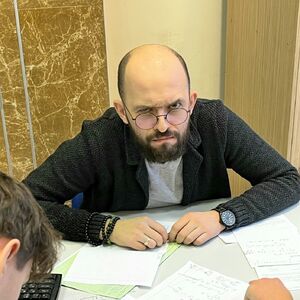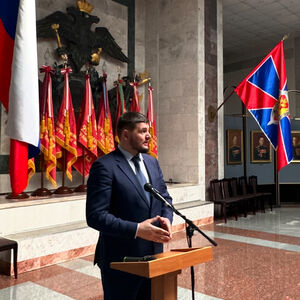Диссертация (1140411), страница 22
Текст из файла (страница 22)
№ 4. ‒ C.65.7. Горемыкин, И.В. Соотношение степени воронкообразной деформациигрудной клетки с тяжестью дисплазии соединительной ткани у детей /И.В.Горемыкин,К.Л.Погосян,Е.А.Лукьяненко//Саратовскийнаучно-медицинский журнал. ‒ 2012. ‒ T. 8, № 3. - С.842-845.8. Разумовский, А.Ю. Торакопластика при килевидной деформации груднойклетки у детей / А.Ю.Разумовский, А.Б.Алхасов, В.Е.Рачков, З.Б.Митупов,M.О.Савчук //Хирургия. Журнал им. НИ Пирогова. – 2011. – №.
4. – С. 25-31.9. Кулик, И.О. Этиология и патогенез воронкообразной деформации груднойклетки у детей / И.О.Кулик, В.А.Плякин, О.О.Саруханян, Н.Ю.Игнатьева,С.А.Полюдов //Травматология и ортопедия России. – 2013. – №. 2 (68). - С.136141.17010. Desmarais, T.J. Pectus carinatum / T.J.Desmarais, M.S.Keller // Curr OpinPediatr. ‒ 2013. ‒ Vol.
25, Iss. 3. ‒ P.375-81.11. Кадурина, Т.И. Дисплазия соединительной ткани: рук. для врачей. /Т.И.Кадурина, В.Н.Горбунова. ‒ СПб.: ЭЛБИ-СПб, 2009. ‒ 702 с.12. Кадурина, Т.И. Дисплазия соединительной ткани: путь к диагнозу /Т.И.Кадурина, Л.Н.Аббакумова // Вестник Ивановской медицинской академии.– 2014. – Т. 19. – №. 3. - С.5-11.13. Loeys, B.L. The revised Ghent nosology for the Marfan syndrome / B.L.Loeys,H.C.Dietz, A.C.Braverman et. al. // J Med Genet. ‒ 2010. ‒ Vol. 47, Iss.
7. ‒ P.47685.14. Rimoin, D. L. Emery and Rimoin's essential medical genetics / D.L.Rimoin,R.E.Pyeritz, B.Korf (ed.). – Amsterdam.: Elsevier, 2013. - 646 p.15. Аникин, В.В. Наследственные нарушения соединительной ткани вкардиологии.Г.П.Арутюнов,ДиагностикаиЮ.Б.Белан,лечение/В.В.Аникин,И.А.Виктороваидр.В.Г.Арсентьев,//Российскийкардиологический журнал.
– 2013. – №. 1. – С. 1-32.16. Бардахчьян, Э.А. Особенности ультраструктурных изменений реберногохряща детей при различных деформациях грудной клетки / Э.А.Бардахчьян,Г.И.Чепурной, В.Б.Шамик // Архив патологии. – 2002. – Т. 64. – №. 5. – С. 4045.17. Brochhausen, C. Pectus excavatum: history, hypotheses and treatment options /C.Brochhausen, S.Turial, F.K.Muller et. al.
// Interact Cardiovasc Thorac Surg. ‒2012. ‒ Vol. 14, Iss. 6. ‒ P.801-6.18. Chung, C.S. Factors affecting risks of congenital malformations. I. Analysis ofepidemiologic factors in congenital malformations. Report from the CollaborativePerinatal Project / C.S.Chung, N.C.Myrianthopoulos // Birth Defects Orig Artic Ser.‒ 1975. ‒ Vol. 11, Iss.
10. ‒ P.1-22.19. Park, H.J. The Nuss procedure for pectus excavatum: evolution of techniques andearly results on 322 patients / H.J.Park, S.Y.Lee, C.S.Lee et. al. // Ann Thorac Surg.‒ 2004. ‒ Vol. 77, Iss. 1. ‒ P.289-95.17120. Fokin, A.A. Management of chest wall deformities / A.A.Fokin, F.Robicsek. Advanced therapy in thoracic surgery 2nd ed., Hamilton: BC Decker. ‒ 2005. P.14562.21. Nakahara, K. An evaluation of operative outcome in patients with funnel chestdiagnosed by means of the computed tomogram / K.Nakahara, K.Ohno, S.Miyoshi et.al. // The Journal of thoracic and cardiovascular surgery. ‒ 1987.
‒ Vol. 93, Iss. 4. ‒P.577-582.22. Haller, J.A. Use of CT scans in selection of patients for pectus excavatumsurgery: a preliminary report / J.A.Haller, S.S.Kramer, S.A.Lietman // J Pediatr Surg.‒ 1987. ‒ Vol. 22, Iss. 10. ‒ P.904-906.23. Coln, E. Demonstrating relief of cardiac compression with the Nuss minimallyinvasive repair for pectus excavatum / E.Coln, J.Carrasco, D.Coln // J Pediatr Surg. ‒2006. ‒ Vol.
41, Iss. 4. ‒ P.683-686.24. Fokin, A.A. [X-ray characteristics of keeled chest] / A.A.Fokin // VestnRentgenol Radiol. ‒ 1984. Iss. 3. ‒ P.22-27.25. Fokin, A.A. Pouter pigeon breast / A.A.Fokin // Chest Surg Clin N Am. ‒ 2000. ‒Vol. 10, Iss. 2. ‒ P.377-391.26. Scarci, M. Open repair of pectus carinatum / M.Scarci, L.Bertolaccini,N.Panagiotopoulos et. al. // J Vis Surg. ‒ 2016. ‒ Vol. 2. ‒ P.50.27. Pilegaard, H. Minimal Invasive Repair of Pectus Excavatum and Carinatum /H.Pilegaard, P.B.Licht // Thorac Surg Clin.
‒ 2017. ‒ Vol. 27, Iss. 2. ‒ P.123-131.28. Ravitch, M.M. The Operative Treatment of Pectus Excavatum / M.M.Ravitch //Ann Surg. ‒ 1949. ‒ Vol. 129, Iss. 4. ‒ P.429-44.29. Nuss, D. A 10-year review of a minimally invasive technique for the correction ofpectus excavatum / D.Nuss, R.E.Kelly, D.P.Croitoru et.
al. // J Pediatr Surg. ‒ 1998. ‒Vol. 33, Iss. 4. ‒ P.545-552.30. Mao, Y.Z. Comparison of the Nuss versus Ravitch procedure for pectusexcavatum repair: an updated meta-analysis / Y.Z.Mao, S.Tang, S.Li // J PediatrSurg. ‒ 2017. ‒ Vol. 52, Iss. 10. ‒ P.1545-1552.17231. Kanagaratnam, A. Ravitch versus Nuss procedure for pectus excavatum:systematic review and meta-analysis / A.Kanagaratnam, S.Phan, V.Tchantchaleishviliet. al. // Ann Cardiothorac Surg. ‒ 2016. ‒ Vol.
5, Iss. 5. ‒ P.409-421.32. Jaroszewski, D. Current management of pectus excavatum: a review and updateof therapy and treatment recommendations / D.Jaroszewski, D.Notrica, L.McMahonet. al. // J Am Board Fam Med. ‒ 2010. ‒ Vol. 23, Iss. 2. ‒ P.230-239.33. Савельева, М.С. Торакопластика по D. Nuss и ее модификации в разныхстранах / М.С.Савельева, А.Ю.Разумовский // Детская хирургия. ‒ 2014.
‒ T. 18,№ 1. - С.34-38.34. Park, H.J. How early can we repair pectus excavatum: the earlier the better? /H.J.Park, S.W.Sung, J.K.Park et. al. // Eur J Cardiothorac Surg. ‒ 2012. ‒ Vol. 42,Iss. 4. ‒ P.667-672.35. Funk, J.F. Patient satisfaction and clinical results 10 years after modified openthoracoplasty for pectus deformities / J.F.Funk, C.Gross, R.Placzek // LangenbecksArch Surg.
‒ 2011. ‒ Vol. 396, Iss. 8. ‒ P.1213-1220.36. Fonkalsrud, E.W. Repair of pectus excavatum and carinatum in adults /E.W.Fonkalsrud, J.Bustorff-Silva // The American journal of surgery. ‒ 1999. ‒ Vol.177, Iss. 2. ‒ P.121-124.37. Mansour, K.A. Thirty-year experience with repair of pectus deformities in adults /K.A.Mansour, V.H.Thourani, E.A.Odessey et. al. // The Annals of thoracic surgery.
‒2003. ‒ Vol. 76, Iss. 2. ‒ P.391-395.38. Kelly, R.E. Pectus excavatum: historical background, clinical picture,preoperative evaluation and criteria for operation / R.E.Kelly Jr.// Semin PediatrSurg. ‒ 2008. ‒ Vol. 17, Iss. 3. ‒ P.181-93.39.
Ebstein, E. Zur Geschichte der familiären Trichterbrust / E.Ebstein // DMWDeutsche Medizinische Wochenschrift. ‒ 1921. ‒ Vol. 47, Iss. 36. ‒ P.1070-1071.40. Greig, J.D. Thoracic cage deformity: a late complication following repair of anagenesis of diaphragm / J.D.Greig, A.F.Azmy // J Pediatr Surg. ‒ 1990.
‒ Vol. 25, Iss.12. ‒ P.1234-1235.17341. Nagasao, T. Irregular location of major pectoral muscle can be a causative factorof pectus excavatum / T.Nagasao, Y.Shimizu, T.Morotomi et. al. // Med Hypotheses.‒ 2014. ‒ Vol. 82, Iss. 5. ‒ P.512-517.42. Schaerer, D. Pectus excavatum in children with laryngomalacia / D.Schaerer,J.Virbalas, E.Willis et. al. // International journal of pediatric otorhinolaryngology. ‒2013.
‒ Vol. 77, Iss. 10. ‒ P.1721-1723.43. Koumbourlis, A.C. Chest wall abnormalities and their clinical significance inchildhood / A.C.Koumbourlis // Paediatric respiratory reviews. ‒ 2014. ‒ Vol. 15, Iss.3. ‒ P.246-255.44. Swanson, J.W. Reactive pectus carinatum in patients treated for pectus excavatum/ J.W.Swanson, P.M.Colombani // Journal of pediatric surgery. ‒ 2008. ‒ Vol. 43, Iss.8.
‒ P.1468-1473.45. Robicsek, F. Surgical repair of pectus excavatum and carinatum / F.Robicsek,L.T.Watts, A.A.Fokin // Seminars in thoracic and cardiovascular surgery. ‒ Vol. 21‒Elsevier, 2009. ‒ P.64-75.46. Franco, K.L. Advanced therapy in thoracic surgery / K.L.Franco, J.B.Putnam. –PMPH-USA, 2005. - 548 p.47. Creswick, H.A. Family study of the inheritance of pectus excavatum /H.A.Creswick, M.W.Stacey, R.E.Kelly et. al. // J Pediatr Surg.
‒ 2006. ‒ Vol. 41, Iss.10. ‒ P.1699-1703.48. Jones, K.L. Smith's Recognizable Patterns of Human Malformation / K.L.Jones,M.C.Jones, M.Del Campo. – Elsevier Health Sciences, 2013. - 979 p.49. Kotzot, D. Etiology of chest wall deformities--a genetic review for the treatingphysician / D.Kotzot, A.H.Schwabegger // J Pediatr Surg. ‒ 2009. ‒ Vol.
44, Iss. 10. ‒P.2004-2011.50. Fokin, A.A. Genetic analysis of connective tissue in patients with congenitalthoracic abnormalities / A.A.Fokin, F.Robicsek, L.Watts et. al. // Interact CardioVascThorac Surg. ‒ 2008. ‒ Vol. 7. ‒ P.56.51. Быков, В. Л. Цитология и общая гистология (функциональная морфологияклеток и тканей человека) / В.Л.Быков. ‒ СПб.: СОТИС, 2013. ‒ 520 с.17452. Омельяненко, Н. П. Соединительная ткань (гистофизиология и биохимия) /Н.П.Омельяненко, Л.И.Слуцкий; под ред. академика РАН и РАМН С.П.Миронова. ‒ М.: "Известия", 2009.
Т. 1. ‒ 379 с.53. Шехтер, А.Б. Фибробласт–фиброкласт: ультраструктурные механизмырезорбции коллагеновых волокон при инволюции соединительной ткани /А.Б.Шехтер , З.П.Милованова // Архив патологии. – 1975. – Т. 38. – С.13-19.54. Shekhter, A.B. Connective tissue as an integral system: role of cell-cell and cellmatrix interactions / A.B.Shekhter // Connect Tissue Res. ‒ 1986. ‒ Vol. 15, Iss. 1-2.‒ P.23-31.55.
Клеменов, А.В. Номенклатура и алгоритм диагностики наследственныхнарушений соединительной ткани / А.В.Клеменов // Клиницист. ‒ 2015. ‒ T. 9,№ 1. - С.42-49.56. Beighton, P. International Nosology of Heritable Disorders of Connective Tissue,Berlin, 1986 / P.Beighton, A. de Paepe, D.Danks, G.Finidori et al.
// Am J MedGenet. ‒ 1988. ‒ Vol. 29, Iss. 3. ‒ P.581-94.57. Яковлев, В.М. Иммунопатологические синдромы при наследственнойдисплазии соединительной ткани / В.М.Яковлев, А.В.Глотов, А.В.Ягода. ‒Ставрополь: ИПФ "Ставрополье". ‒ 2005. - 234 с.58. Beighton, P. Ehlers-Danlos syndromes: revised nosology, Villefranche, 1997.Ehlers-Danlos National Foundation (USA) and Ehlers-Danlos Support Group (UK) /P.Beighton, A.D.Paepe, B.Steinmann et al. // Am J Med Genet.
‒ 1998. ‒ Vol. 77,Iss. 1. ‒ P.31-7.59. Grahame, R. The revised (Brighton 1998) criteria for the diagnosis of benign jointhypermobility syndrome (BJHS) / R.Grahame, H.A.Bird, A.Child // J Rheumatol. ‒2000. ‒ Vol. 27, Iss. 7. ‒ P.1777-1779.60. Bonow, R.O. 2008 focused update incorporated into the ACC/AHA 2006guidelines for the management of patients with valvular heart disease: a report of theAmerican College of Cardiology/American Heart Association Task Force on PracticeGuidelines (Writing Committee to revise the 1998 guidelines for the management ofpatients with valvular heart disease) Endorsed by the Society of Cardiovascular175Anesthesiologists, Society for Cardiovascular Angiography and Interventions, andSociety of Thoracic Surgeons / R.O.Bonow, B.A.Carabello, K.Chatterjee et al.
















